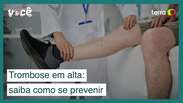Work session, Covid-19 and contraceptives explain the explosion of cases
Summary
Renata Rafaldini discovered that she had thrombosis on the day of saphenous vein surgery, caused by bad habits such as excessive sedentary lifestyle and smoking, which require treatment with anticoagulants and the use of elastic stockings. The SUS recorded 21 thousand cases in 2012 and 35 thousand in 2022.
-
BY PARTICIPATING

Increase in cases of thrombosis: find out how to prevent it
-
BY PARTICIPATING
-1hrj7kwtui63n.jpg)
What are the differences between anxiety and depression?
-
BY PARTICIPATING

Discover the silent diseases that prevent you from getting pregnant
-
BY PARTICIPATING

Discover Brazilian fruits that help fight diseases
Without any symptoms, Renata Rafaldini discovered, on the day she was supposed to undergo saphenous vein surgery, that she had a thrombosis. “The vascular surgeon, doing the ultrasound to begin the operation, noticed that the vein was blocked. I did not hear anything. As during the pandemic, she asked me to take a test for Covid-19 and it came back positive. She was completely asymptomatic,” reports Renata.
He treated the thrombosis with the use of anticoagulants for a few days, prescribed by the doctor. “And then I had to take circulation medicine and wear elastic stockings for a long time,” says Renata.
Ten years ago, thrombosis seemed like a very distant disease, present in the offices of vascular surgeons, but unknown to the general public. Today it is rare not to know someone who has encountered this problem. The disease affects people who spend a lot of time sitting, are overweight, sedentary and smokers, as well as long-distance travelers and those diagnosed with Covid-19.
It occurs when a blood clot forms in the veins of the legs due to inadequate circulation, thus preventing the passage of blood.
“Thrombosis generally manifests as pain in the leg, especially in the calf, associated with persistent swelling, heat, tenderness and redness, which almost always leads to seeking medical help. Just as the heart pumps arterial blood to distribute oxygenated blood to the body, 90% of the circulation in the legs is provided by the calf muscle. When the calf pump does not work properly, blood begins to accumulate in the limbs, which is more likely to form clots,” underlines the vascular surgeon. Aline Lamaitamember of the Brazilian Society of Angiology and Vascular Surgery.
“In more rare cases, the clot can also detach from the wall of the vein and travel through the circulation until it reaches the lung, causing a pulmonary embolism which can even lead to sudden death,” underlines the doctor.
The SUS numbers
The numbers don’t lie. According to data from the SUS (Unified Health System), in 2012 Brazil had 21 thousand cases of venous thrombosis and 59 daily hospitalizations and, in 2022, this number jumped to over 35 thousand hospitalizations, with an average of 98 hospitalizations per day. Only until October 2023 the average daily hospitalizations was 105.
These people went to the doctor because they experienced symptoms such as pain in the leg, especially in the calf, associated with persistent swelling, heat, tenderness and redness, color change in the region and difficulty moving.
“And the attention to the disease must be doubled by those who have individual factors that aggravate the risk of thrombosis, such as obesity, smoking, the use of hormones and contraceptive pills, cancer patients, people with increased predisposition blood clotting, pregnant women, the elderly, the physically disabled and people with varicose veins,” he explains.
“If you experience these symptoms, the most important thing is that you seek medical treatment to prevent the disease from progressing to a pulmonary embolism, which has chest pain, cough, tiredness and unexpected shortness as symptoms,” he adds.
“In general, the treatment of the disease involves the use of anticoagulant drugs that will help reduce the viscosity of the blood and dissolve the clot, thus preventing its growth and advancement to other regions and also preventing the onset of new cases of thrombosis ”, says the vascular surgeon.
What explains this increase in cases?
“Today we consider sitting as our new cigarette. Humans were designed to be mobile, and immobility is related to several diseases, including thrombosis. It’s important to maintain an active day, regardless of exercise. Doing an hour of exercise a day is fine, but if you sit the rest of the time, it continues to be dangerous,” warns Aline Lamaita.
The daily habit of spending hours in front of the television can also be a problem. A 2018 study published in Journal of Thrombosis and Thrombolysis have shown that even individuals who regularly engage in physical activity should not ignore the potential harm of prolonged sedentary behavior, such as watching television, as it is associated with the appearance of blood clots.
“The justification is that sitting for long periods can reduce blood flow to the legs and feet. The best solution would be, instead of doing a daily marathon of non-stop series and films, to alternate it with some activity that moves the legs”, underlines Aline.
The problem for those who work sitting down
For those who work sitting and spend hours in the same position, the doctor suggests: every working hour get up, walk for 5 minutes, move your legs, stretch; invest in an elastic compression stocking (consult your doctor to find out the ideal model); and drinking water, which helps the body function and blood flow.
“Leave the water a little far away, just enough to get up from the chair to get it, but don’t forget to drink it,” explains Aline.
The doctor explains that another reason is the Covid-19 virus. “In general, the incidence of thrombosis in Covid-19 patients can reach 16%, but this obviously in those patients admitted to hospital, who will have more serious conditions. But the disease itself can be related to thrombosis, even in asymptomatic patients. They can only have deep vein thrombosis as a manifestation of Covid-19, which we often see in vascular clinics since the beginning of the pandemic, so this has also increased and entered our list as a risk factor for thrombosis”, explains .Alina .
Cigarettes always make everything worse
In addition to a sedentary lifestyle and Covid-19, smoking also increases the risk of thrombosis, as nicotine is linked to the reduction of the thickness of blood vessels.
“Furthermore, carbon monoxide offers an additional risk factor by reducing the concentration of oxygen in the blood. The whole process can cause complications for the normal functioning of the vessels, which are more prone to becoming clogged, which can lead to thrombosis processes, especially when risk factors are involved,” says the doctor.
Another risk is linked to the use of the contraceptive pill which, if combined, can increase the incidence of thrombosis by 3 to 5 times depending on the type of pill and the method of administration.
“This happens because the amount of hormones present in contraceptive pills can alter circulation, increasing the risk of clots forming in the deep veins. Therefore the use of this method is not recommended for women who are already predisposed to the problem”, explains the doctor.
“Pills with high doses of estrogen are also more likely to cause hypertension, especially in women who smoke, are over 35, or already have hypertension,” she adds.
The ideal is to always consult a doctor. “Only the gynecologist will be able to carry out an assessment taking into account factors such as medical and family history and then recommend the contraceptive method best suited to you, be it hormonal or barrier,” explains Aline.
Risks of thrombosis
In thrombosis, the blood clots, turns into jelly, interrupting blood flow and causing circulation problems in the affected limb, and increasing the risk of pulmonary embolism, due to detachment of the thrombus, which can lead to sudden death.
“Another common complication of venous thrombosis, but little talked about, is called post-thrombotic syndrome. This occurs due to the circulatory deficit that occurs in the affected limb, leading to serious circulatory alterations, with edema, changes in skin color (dermatitis) and even the appearance of wounds such as varicose ulcers,” explains the doctor.
In most cases, the disease resolves with treatment. However, the problem can recur, especially in people with a predisposition to thrombosis. Therefore, it is important to pay attention to prevent the problem.
“Certain measures that aim to improve circulation can help prevent thrombosis. It is therefore advisable to stop smoking, drink lots of water, adopt a balanced diet, do physical activity regularly and avoid spending a lot of time in the same position, both during working hours and during long journeys, getting up every hour to move around a little. ‘. ”, underlines the vascular surgeon.
According to Aline, the use of elastic stockings could also be recommended, since these stockings compress the blood vessels, improving venous return and, consequently, preventing vascular problems such as varicose veins and thrombosis.
“However, the most important thing is to regularly consult a vascular surgeon, especially if you have a predisposition or individual aggravating factors associated with the disease. Only he will be able to monitor your situation, make a correct diagnosis and, if necessary, recommend the most suitable treatment,” he concludes.
inspires transformation in the world of work, in business, in society. Compasso, a content and connection agency, is born.
Source: Terra
Ben Stock is a lifestyle journalist and author at Gossipify. He writes about topics such as health, wellness, travel, food and home decor. He provides practical advice and inspiration to improve well-being, keeps readers up to date with latest lifestyle news and trends, known for his engaging writing style, in-depth analysis and unique perspectives.








